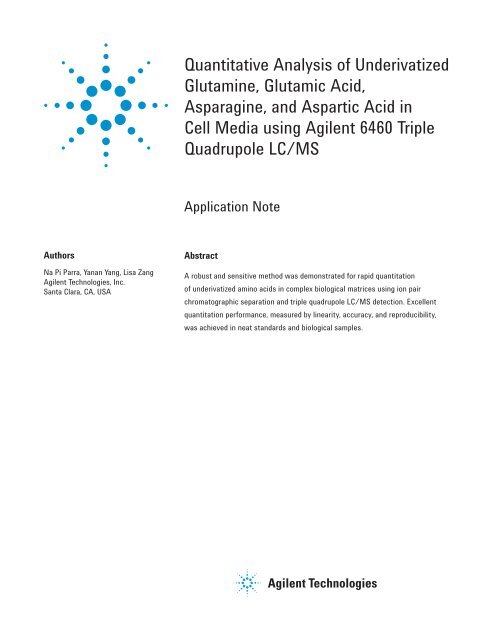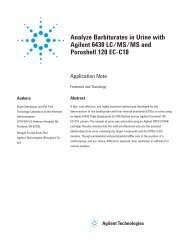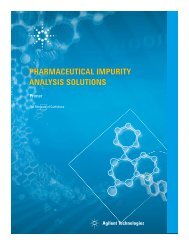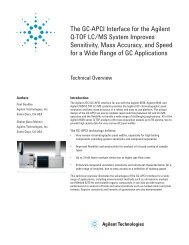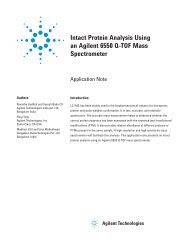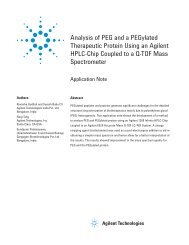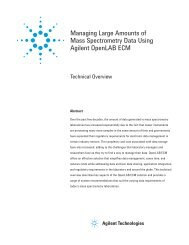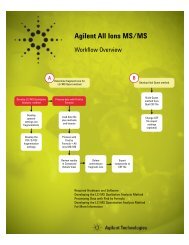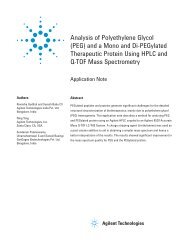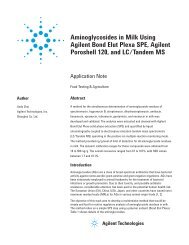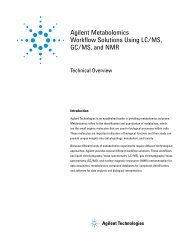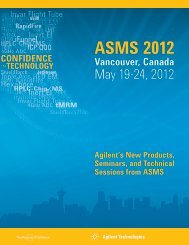Quantitative Analysis of Underivatized Glutamine, Glutamic Acid ...
Quantitative Analysis of Underivatized Glutamine, Glutamic Acid ...
Quantitative Analysis of Underivatized Glutamine, Glutamic Acid ...
Create successful ePaper yourself
Turn your PDF publications into a flip-book with our unique Google optimized e-Paper software.
<strong>Quantitative</strong> <strong>Analysis</strong> <strong>of</strong> <strong>Underivatized</strong><strong>Glutamine</strong>, <strong>Glutamic</strong> <strong>Acid</strong>,Asparagine, and Aspartic <strong>Acid</strong> inCell Media using Agilent 6460 TripleQuadrupole LC/MSApplication NoteAuthorsNa Pi Parra, Yanan Yang, Lisa ZangAgilent Technologies, Inc.Santa Clara, CA, USAAbstractA robust and sensitive method was demonstrated for rapid quantitation<strong>of</strong> underivatized amino acids in complex biological matrices using ion pairchromatographic separation and triple quadrupole LC/MS detection. Excellentquantitation performance, measured by linearity, accuracy, and reproducibility,was achieved in neat standards and biological samples.
Introduction<strong>Glutamine</strong> (Gln), glutamic acid (Glu),asparagine (Asn), and aspartic acid(Asp) (Figure 1 and Table 1) areimportant amino acids in the fields<strong>of</strong> medicine, food industry, andmetabolomics and clinical research. 1,2Quantitation <strong>of</strong> amino acids in acomplex biological matrix withoutderivatization 3,4 is advantageous as iteliminates laborious sample preparationprocedures and reduces potentialexperimental errors. However, dueto the highly hydrophilic nature <strong>of</strong>these compounds, LC/MS analysisis challenging because they havepoor chromatographic separation andLC retention, especially in complexbiological matrices. In this applicationnote, a rapid and sensitive LC/MS/MSmethod is presented for the separationand quantitation <strong>of</strong> Gln, Glu, Asn, andAsp in cell media using an Agilent 1290Infinity UHPLC System coupled to anAgilent 6460 Triple Quadrupole LC/MSwith Jet Stream technology. Themethod uses an ion pairing reagent,heptafluorobutyric acid (HFBA), toachieve baseline chromatographicseparation. Therefore, it eliminatesamino acid derivatization and preventssignal interference between amino acidpairs (for example Gln and Glu, and Asnand Asp). The method demonstratedexcellent sensitivity, linearity, dynamicrange, accuracy, reproducibility,and precision. Ion pairing liquidchromatography in combination withtriple quadrupole MRM detectionprovides a valuable approach forquantitation <strong>of</strong> underivatized aminoacids in the pharmaceutical industryand clinical laboratories.H 2NOOOOH HONH 2ONH 2OH<strong>Glutamine</strong><strong>Glutamic</strong> acidOOOOHNH 2NH 2OHONH 2OHAsparagineAspartic acidFigure 1. <strong>Underivatized</strong> glutamine, glutamic acid, asparagine, and aspartic acid.Table 1. Four amino acid test compounds.Amino acid name Formula MassAsparagine C 4H 8N 2O 3132.12Aspartic acid C 4H 7NO 4133.10<strong>Glutamine</strong> C 5H 10N 2O 3146.14<strong>Glutamic</strong> acid C 5H 9NO 4147.132
ExperimentalSample PreparationNeat calibration standards containinga mixture <strong>of</strong> the four amino acidswere prepared in water from 5 to100,000 nM (Table 2). Cell mediacalibration standards were prepared byspiking the four amino acids at variedconcentrations (0.5 – 10,000 μM).Media A is RPMI 1640 without Gln andmedia B is media A + 5 % fetal bovineserum. Unknown samples 1 – 6 wereprepared by spiking different levels <strong>of</strong>Gln in media A, while unknown samples7 and 8 were prepared by spiking Glnin media B. The cell media calibrationstandards and the eight unknown cellmedia samples (100 µL) were extractedusing ice cold acetonitrile (200 µL).After centrifugation, the supernatant(100 µL) was diluted 100 times in waterbefore LC/MS/MS analysis.InstrumentationLiquid chromatography wasperformed on a 1290 Infinity UHPLCSystem consisting <strong>of</strong> a binary pump,vacuum degasser, high performancethermostatted autosampler, and athermostatted column compartment.LC/MS/MS analysis was performedon a 6460 Triple Quadrupole LC/MSequipped with an Agilent Jet Streamsource in positive ionization mode.Source conditions were optimized forquantitative analysis <strong>of</strong> amino acids(Table 3). The specific MRM transitionsused for quantitation <strong>of</strong> Gln, Glu, Asn,and Asp and the optimized compounddependent MRM parameters, such asfragmentor voltage and collision energy,are summarized in Table 4.Table 2. Calibration standard solutions <strong>of</strong> the four amino acids in water.Level Injection volumn (µL) Concentration (nM) Concentration (fmol on-column)1 1 5 52 1 10 103 1 50 504 1 100 1005 1 500 5006 1 1,000 1,0007 1 5,000 5,0008 1 10,000 10,0009 1 50,000 50,00010 1 100,000 100,000Table 3. Liquid chromatography and triple quadrupole MS source conditions.LC ConditionsColumn Agilent ZORBAX SB-C18 Rapid Resolution HB column, 3.0 × 50 mm, 1.8 µm(p/n: 829975-302)Column temperature 25 °CInjection volume 1 µLAutosampler temperature 4 °CNeedle wash10 seconds in wash portMobile phaseA = 0.5 % formic acid and 0.3 % HFBA in waterB = 0.5 % formic acid and 0.3 % HFBA in acetonitrileFlow rate0.4 mL/minGradient program Time (min) A (%) B (%)Initial 100 05.00 95 55.01 10 906.00 10 906.01 100 0Post time1 minTriple quadrupole MS source conditionsIon modePositiveDrying gas temperature 275 °CDrying gas flow9 L/minSheath gas temperature 325 °CSheath gas flow12 L/minNebulizer pressure 40 psiCapillary voltage3750 VNozzle voltage0 VDelta EMV0 V3
Data acquisition and analysisA MassHunter Workstation (versionB.03.01) was used for data acquisition.MassHunter Qualitative <strong>Analysis</strong>(version B.03.01) and <strong>Quantitative</strong><strong>Analysis</strong> S<strong>of</strong>tware (version B.04.00)were used for data processing. The twomost abundant MRM transitions wereselected for each analyte as quantifierand qualifier ions, the ratio <strong>of</strong> whichwas used as confirmatory evidencefor the analyte <strong>of</strong> interest in biologicalmatrices.Table 4. Agilent triple quadrupole MRM acquisition method parameters.Compound name Precursor ionMS1resolution Product ionMS2resolutionFragmentor(V) CE (V)Asparagine 133.1 Unit 74.1 Unit 74 10Asparagine 133.1 Unit 87.1 Unit 74 4Aspartic acid 134.0 Unit 74.0 Unit 80 10Aspartic acid 134.0 Unit 88.0 Unit 80 5<strong>Glutamine</strong> 147.1 Unit 84.1 Unit 80 15<strong>Glutamine</strong> 147.1 Unit 130.1 Unit 80 5<strong>Glutamic</strong> acid 148.1 Unit 84.1 Unit 80 14<strong>Glutamic</strong> acid 148.1 Unit 130.1 Unit 80 4Results and Discussion×10 3 +ESI MRM Frag=80.0 VAs demonstrated in Figure 2, the fouramino acids were well separated withretention times <strong>of</strong> 3.00, 3.48, 3.89, and4.61 minutes for Asn, Asp, Gln, and Glu,respectively. The baseline separation<strong>of</strong> the four amino acids preventedMRM signal interference <strong>of</strong> Gln(m/z 147.1 > 84.1) to Glu (m/z 148.1> 84.1), as well as Asn (m/z 133.1 >74.1) from Asp (m/z 134.1 > 74.1). Thissignificantly improved the quantitationperformance, for example sensitivity,linearity, and accuracy.Counts Counts Counts Counts10 µM calibration standard×10 4+ESI MRM Frag = 80.0 V4321×10 4+ESI MRM Frag = 80.0 V42×10 4+ESI MRM Frag = 80.0 V21×10 4+ESI MRM Frag = 74.0 V43212.521.510.54 4.5 5+ESI MRM Frag=80.0 V×10 321.751.51.2510.750.50.252.8 3 3.2 3.4 3.6<strong>Glutamic</strong> acid148.1 → 84.1<strong>Glutamine</strong>147.1 → 84.1Aspartic acid134.0 → 74.0Asparagine133.1 → 74.10.8 1.2 1.6 2 2.4 2.8 3.2 3.6 4 4.4 4.8 5.2 5.6 6Acquisition time (min)Figure 2. MRM chromatograms <strong>of</strong> the four amino acids.4
SensitivityThe limits <strong>of</strong> detection (LOD) are 5, 10,5, and 10 nM, or 5, 10, 5, and 10 fmolon-column for Asn, Asp, Gln, and Glu,respectively, with a signal-to-noiseratio <strong>of</strong> > 3:1 (Figure 3). The limits<strong>of</strong> quantitation (LOQ) are 5, 10, 5,and 50 nM, or 5, 10, 5, and 50 fmolon-column for Asn, Asp, Gln, and Glu,respectively, with a signal-to-noiseratio <strong>of</strong> > 5:1 (Figure 3). As illustratedby Figure 3, excellent reproducibility(% RSD < 5 from triplicate results)<strong>of</strong> both retention time and peak arearesponse was obtained at the LOQlevels. Since the four amino acids havetheir endogenous concentrations incell media, LOD and LOQ levels are notevaluated in cell media.Asn: LOD = LOQ = 5 fmolAsp: LOD = LOQ = 10 fmol×10 21Counts×10 21×10 21+ESI MRM Frag=74.0 V5 nM+ESI MRM Frag=74.0 V5 nM+ESI MRM Frag=74.0 V5 nM*3.0101*3.0100*3.098×10 2 +ESI MRM Frag=80.0 VCounts10 nM21×10 2 +ESI MRM Frag=80.0 V2 10 nM1×10 2 +ESI MRM Frag=80.0 V10 nM1*3.5497*3.5442*3.54561.6 1.8 2 2.2 2.4 2.6 2.8 3 3.2 3.4Acquisition time (min)1 1.5 2 2.5 3 3.5 4 4.5 5Acquisition time (min)×10 2×10 2×10 2 +ESI MRM Frag=80.0 V+ESI MRM Frag=80.0 V+ESI MRM Frag=80.0 V×10 2 ×10 2 ×10 2*3.9*4.65 nM10 nM50 nm4838652551×10 2 +ESI MRM Frag=80.0 V×10 2 +ESI MRM Frag=80.0 V+ESI MRM Frag=80.0 V×10 22 5 nM *3.95 10 nM *4.6447447550 nM12.5+ESI MRM Frag=80.0 V+ESI MRM Frag=80.0 V+ESI MRM Frag=80.0 V2*3.94*4.65 nM10 nM426443550 nM12CountsGln: LOD = LOQ = 5 fmolCountsGlu: LOD = 10 fmol3 3.23.43.63.8 4 4.24.44.64.8 5 5.25.45.65.8 6 4 4.2 4.4 4.6 4.8 5 5.2 5.4 5.6 5.8 6 6.2 6.4 6.6 4 4.2 4.4 4.6 4.8 5 5.2 5.4 5.6 5.8 6 6.2 6.4 6.6Acquisition time (min) Acquisition time (min) Acquisition time (min)Figure 3. MRM chromatograms <strong>of</strong> Asn, Asp, Gln, and Glu at their LOD and LOQ levels (3 replicate injections).CountsGlu: LOQ = 50 fmol*4.61205*4.61206*4.612065
Calibration curve linearity andrangeThe calibration curves for the fouramino acids in water (Figure 4) and incell media (Figure 5) show excellentlinearity (R 2 > 0.999) and wide dynamicrange (≥ 3 orders). Notably, thedynamic range for Gln in water isgreater than 4 orders <strong>of</strong> magnitude(5 – 100,000 nM). The inserts inFigure 4 demonstrate the excellentdetection accuracy and reproducibilityeven at low concentration levels (thatis LOQ levels indicated in the previoussection).×10 5 Asparagine: 5 – 10,000 nM R 2 = 0.9996×10 6Aspartic acid: 10 – 100,000 nMResponses1.201.050.900.750.600.450.300.150Responses×10 31.00.80.4010 30 50 70 90Concentration (nM)Responses1.01.91.80.70.60.50.40.30.20.105432100 100 200 300 400×10 3 500Concentration (nM)ResponsesR 2 = 0.99910 1,000 2,000 3,000 4,000 5,000 6,000 7,000 8,000 9,000 10,000Concentration (nM)0 20,000 40,000 60,000 80,000 100,000Concentration (nM)Responses×10 6 <strong>Glutamine</strong>: 5 – 100,000 nM×10 6 <strong>Glutamic</strong> acid: 50 – 100,000 nM2.7×10 2.73 ×10 42.4 0.81.51.02.42.1 0.81.00.81.81.8 0.80.50.41.5 01.5 010 30 50 70 900 200 400 600 800 1000Concentration (nM)1.2Concentration (nM)1.20.90.90.6R 2 = 0.99910.60.30.300ResponsesResponsesResponsesR 2 = 0.99990 20,000 40,000 60,000 80,000 100,000Concentration (nM)0 20,000 40,000 60,000 80,000 100,000Concentration (nM)Figure 4. Calibration curves <strong>of</strong> Asn, Asp, Gln, and Glu in water. Inserts demonstrate low concentration range.6
Accuracy, reproducibility, andprecisionThe accuracy, reproducibility, andprecision were evaluated for eachamino acid at nine to ten standardconcentrations. The results obtainedfrom analytes in water and in cell mediaare summarized in Table 5. Comparableaccuracy, reproducibility, and precisionwere achieved for both neat andcell media standards, demonstratingexcellent quantitation performance <strong>of</strong>the LC/MS/MS method in biologicalmatrices.Responses×10 5 Asparagine: Spike 1 − 1,000 μM in cell media1.81.71.61.51.41.31.21.110.90.80.7R 2 = 0.99900.60.50.4350 450 550 650 750 850 950 1,050 1,150 1,250 1,350 1,450Concentration (µM)Responses6.565.554.543.532.521.510.50×10 5 Aspartic acid: Spike 5 − 5,000 μM in cell mediaR 2 = 0.99950 500 1,000 1,500 2,000 2,500 3,000 3,500 4,000 4,500 5,000 5,500Concentration (µM)×10 6 Concentration (µM)Responses1.41.31.21.110.90.80.70.60.50.40.30.20.10-0.1<strong>Glutamine</strong>: Spike 0.5 − 5,000 μM in cell mediaR 2 = 0.99970 500 1,000 1,500 2,000 2,500 3,000 3,500 4,000 4,500 5,000Responses9876543210<strong>Glutamic</strong> acid: Spike 5 − 5,000 μM in cell mediaR 2 = 0.999950 500 1,000 1,500 2,000 2,500 3,000 3,500 4,000 4,500 5,000 5,500×10 5 Concentration (µM)Figure 5. Calibration curves <strong>of</strong> Asn, Asp, Gln, and Glu in cell media (RPMI 1640 without Gln).Table 5. Accuracy, reproducibility, and precision results in water and in cell media.WaterCell mediaAmino acid name Accuracy (%)Reproducibility(% RSD, n = 3)Precision(%RSD, n =10) Accuracy (%)Reproducibility(% RSD, n = 3)Precision(% RSD, n =9)Asparagine 84.4 – 107.0 0.55 – 4.27 7.23 98.6 – 102.6 0.03 – 4.07 1.53Aspartic acid 92.4 – 112.8 0.48 – 1.98 8.63 94.1 – 103.6 0.09 – 3.90 2.82<strong>Glutamine</strong> 86.7 – 109.7 0.14 – 1.09 8.03 94.7 – 105.2 0.23 – 5.42 4.59<strong>Glutamic</strong> acid 82.0 – 109.6 0.22 – 3.54 5.61 98.3 – 101.1 0.13 – 0.75 1.087
Quantitation <strong>of</strong> amino acids incell media samplesThe LC/MS/MS method wassuccessfully implemented to measurethe concentrations <strong>of</strong> the four aminoacids in media A, media B, and theeight unknown cell media samples(Figures 6 & 7). The measured aminoacid concentrations in the unknownsamples were very consistent withpreviously spiked values. The resultsin Table 6 demonstrate excellentreproducibility (% RSD < 5 %).Table 6. Measured concentration in cell media samples.Asparagine Aspartic acid <strong>Glutamine</strong> <strong>Glutamic</strong> acidMedia A and unknowns Conc. (µM) %RSD (n = 3) Conc. (µM) %RSD (n = 3) Conc. (µM) %RSD (n = 3) Conc. (µM) %RSD (n = 3)Media A 397.8 0.9 270.3 3.0 7.3 0.9 174.0 0.31 393.3 0.5 260.8 0.7 13.0 0.3 167.0 0.12 395.4 4.1 254.6 1.2 7.0 0.4 164.5 1.43 390.3 2.9 264.7 0.5 1071.3 1.4 173.0 1.44 391.2 2.7 264.2 0.9 6.8 0.1 168.8 0.65 397.9 1.9 267.5 1.0 6.9 0.6 170.7 0.36 407.7 4.6 257.2 4.3 271.3 2.4 171.7 0.6Asparagine Aspartic acid <strong>Glutamine</strong> <strong>Glutamic</strong> acidMedia B and unknowns Conc. (µM) %RSD (n = 3) Conc. (µM) %RSD (n = 3) Conc. (µM) %RSD (n = 3) Conc. (µM) %RSD (n = 3)Media B 326.8 1.8 241.8 1.1 26.3 1.8 179.5 1.67 334.0 1.0 244.5 1.1 3930.8 1.0 199.0 1.98 347.6 0.5 256.6 1.2 29.9 1.6 199.1 1.28
×10 51.41.31.21.11+ESI TIC MRM CID@** (** -> **) 16_M1-r001.dMedia 1Unknown 1Unknown 2Unknown 3Unknown 4Unknown 5Unknown 6GlnUnknown 30.9Counts0.80.70.60.50.40.3AsnUnknown 2Unknown 4Unknown 5Unknown 6Unknown 10.20.1AspGlu2.4 2.6 2.8 3 3.2 3.4 3.6 3.8 4 4.2 4.4 4.6 4.8 5 5.2Acquisition time (min)Figure 6. Overlaid LC/MS/MS chromatograms <strong>of</strong> media A and unknown 1 – 6.×10 55.0 +ESI TIC MRM CID@** (** -> **) 36_Unknown 11-r001.d4.64.2Media BUnknown 7Unknown 8GlnUnknown 73.83.43.0Counts2.62.21.81.41.00.6AsnUnknown 80.2AspGlu2.4 2.6 2.8 3 3.2 3.4 3.6 3.8 4 4.2 4.4 4.6 4.8 5 5.2Acquisition time (min)Figure 7. Overlaid LC/MS/MS chromatograms <strong>of</strong> media B and unknown 7 and 8.9
ConclusionsThis application note describes a rapidand sensitive LC/MS/MS methodfor the quantitation <strong>of</strong> amino acids incomplex biological samples withoutderivatization. Baseline separation <strong>of</strong>Asn, Asp, Gln, and Glu was achievedusing ion paring chromatography. TheLC/MS/MS method demonstratesexcellent sensitivity with an LOQ<strong>of</strong> low-fmol level on column. Greatlinearity (> 0.999), dynamic range(≥ 3 orders), accuracy (82 – 113 %),precision (< 6 %), and reproducibility(< 9 %) were observed for all fouramino acids.References1. Neu, J., DeMarco, V., Li N.,<strong>Glutamine</strong>: clinical applications andmechanisms <strong>of</strong> action. Curr. Opin. Clin.Nutr. Metab. Care, 2002, 5:69-75.2. Rapid Screening <strong>of</strong> Amino <strong>Acid</strong>s inFood by CE-ESI-MS. Agilent applicationnote publication 5968-8952E.3. Improved Amino <strong>Acid</strong> Methodsusing Agilent ZORBAX Eclipse PlusC18 Columns for a Variety <strong>of</strong> Agilent LCInstrumentation and Separation Goals.Agilent application note publication5990-4547EN.4. Rapid and Precise Determination <strong>of</strong>Cellular Amino <strong>Acid</strong> Flux Rates UsingHPLC with Automated Derivatizationwith Absorbance Detection.Agilent application note publication5990-3283EN.www.agilent.com/chem/QQQThis information is subject to change without notice.© Agilent Technologies, Inc., 2013Published in the USA, February 1, 20135991-0904EN


